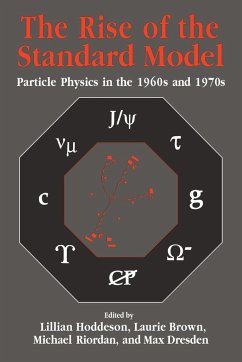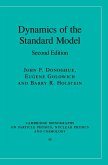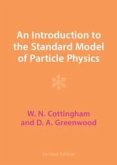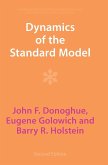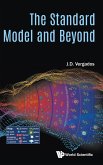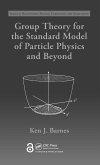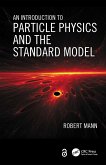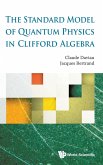The Rise of the Standard Model
A History of Particle Physics from 1964 to 1979
Herausgeber: Brown, Laurie M.; Riordan, Michael; Dresden, Max
The Rise of the Standard Model
A History of Particle Physics from 1964 to 1979
Herausgeber: Brown, Laurie M.; Riordan, Michael; Dresden, Max
- Broschiertes Buch
- Merkliste
- Auf die Merkliste
- Bewerten Bewerten
- Teilen
- Produkt teilen
- Produkterinnerung
- Produkterinnerung
This volume explores the rise of the Standard Model in modern particle physics.
Andere Kunden interessierten sich auch für
![Dynamics of the Standard Model Dynamics of the Standard Model]() John F. DonoghueDynamics of the Standard Model80,99 €
John F. DonoghueDynamics of the Standard Model80,99 €![An Introduction to the Standard Model of Particle Physics An Introduction to the Standard Model of Particle Physics]() W N CottinghamAn Introduction to the Standard Model of Particle Physics116,99 €
W N CottinghamAn Introduction to the Standard Model of Particle Physics116,99 €![Dynamics of the Standard Model Dynamics of the Standard Model]() John F. DonoghueDynamics of the Standard Model137,99 €
John F. DonoghueDynamics of the Standard Model137,99 €![STANDARD MODEL AND BEYOND, THE STANDARD MODEL AND BEYOND, THE]() Vergados J DSTANDARD MODEL AND BEYOND, THE115,99 €
Vergados J DSTANDARD MODEL AND BEYOND, THE115,99 €![Group Theory for the Standard Model of Particle Physics and Beyond Group Theory for the Standard Model of Particle Physics and Beyond]() Ken J. BarnesGroup Theory for the Standard Model of Particle Physics and Beyond114,99 €
Ken J. BarnesGroup Theory for the Standard Model of Particle Physics and Beyond114,99 €![An Introduction to Particle Physics and the Standard Model An Introduction to Particle Physics and the Standard Model]() Robert MannAn Introduction to Particle Physics and the Standard Model112,99 €
Robert MannAn Introduction to Particle Physics and the Standard Model112,99 €![STANDARD MODEL OF QUANTUM PHYSICS IN CLIFFORD ALGEBRA, THE STANDARD MODEL OF QUANTUM PHYSICS IN CLIFFORD ALGEBRA, THE]() Daviau ClaudeSTANDARD MODEL OF QUANTUM PHYSICS IN CLIFFORD ALGEBRA, THE107,99 €
Daviau ClaudeSTANDARD MODEL OF QUANTUM PHYSICS IN CLIFFORD ALGEBRA, THE107,99 €-
-
-
Produktdetails
- Produktdetails
- Verlag: Cambridge University Press
- Seitenzahl: 748
- Erscheinungstermin: 31. Mai 2006
- Englisch
- Abmessung: 234mm x 156mm x 40mm
- Gewicht: 1115g
- ISBN-13: 9780521578165
- ISBN-10: 0521578167
- Artikelnr.: 21469636
- Herstellerkennzeichnung
- Libri GmbH
- Europaallee 1
- 36244 Bad Hersfeld
- gpsr@libri.de
- Verlag: Cambridge University Press
- Seitenzahl: 748
- Erscheinungstermin: 31. Mai 2006
- Englisch
- Abmessung: 234mm x 156mm x 40mm
- Gewicht: 1115g
- ISBN-13: 9780521578165
- ISBN-10: 0521578167
- Artikelnr.: 21469636
- Herstellerkennzeichnung
- Libri GmbH
- Europaallee 1
- 36244 Bad Hersfeld
- gpsr@libri.de
Contributors
Editors' acknowledgements
Photographs of the symposium
Abbreviations and acronyms
Mathematical notation
Part I. Introduction: 1. The rise of the standard model: 1964-1979 Laurie M. Brown, Michael Riordan, Max Dresden, and Lillian Hoddeson
2. Changing attitudes and the standard model Steven Weinberg
3. Two previous standard models J. L. Heilbron
Part II. Quarks and Leptons: 4. From the psi to charmed mesons: three years with the SLAC-LBL detector at SPEAR Gerson Goldhaber
5. The discovery of the tau lepton Martin Perl
6. The discovery of the upsilon, bottom quark and B mesons Leon M. Lederman
7. The discovery of CP violation James Cronin
8. Flavor mixing and CP violation Makoto Kobayashi
Part III. Toward Gauge Theories: 9. The path to renormalizability Martinus Veltman
10. Renormalization of gauge theories Gerard 't Hooft
11. Asymptotic freedom and the emergence of QCD David Gross
12. Quark confinement Leonard Susskind
13. A view from the island Alexander Polyakov
14. On the early days of the renormalization group Dmitrij V. Shirkov
Part IV. Accelerators, Detectors, and Laboratories: 15. The rise of colliding beams Burton Richter
16. The CERN intersecting storage rings: the leap into the hadron collider era Kjell Johnsen
17. Development of large detectors for colliding-beam experiments Roy Schwitters
18. Pure and hybrid detectors: mark I and the psi Peter Galison
19. Building fermilab: a user's paradise Robert R. Wilson and Adrienne Kolb
20. Panel session: science policy and the social structure of big laboratories Catherine Westfall
21. Some sociological consequences of high-energy physicists' development of the standard model Mark Bodnarczuk
22. Comments on accelerators, detectors, and laboratories John Krige
Part V. Electroweak Unification: 23. The first gauge theory of the weak interactions Sidney Bludman
24. The early history of high-energy neutrino physics Melvin Schwartz
25. Gargamelle and the discovery of neutral currents Donald Perkins
26. What a fourth quark can do John Iliopoulos
27. Weak-electromagnetic interference in polarized electron-deuteron scattering Charles Prescott
28. Panel session: spontaneous breaking of symmetry Laurie M. Brown, Robert Brout, Tian Yu Cao, Peter Higgs, and Yoichiro Nambu
Part VI. The Discovery of Quarks and Gluons: 29. Early baryon and meson spectroscopy culminating in the discovery of the omega-minus and charmed baryons Nicholas Samios
30. Quark models and quark phenomenology Harry Lipkin
31. From the nonrelativistic quark model to QCD and back Giacomo Morpurgo
32. Deep-inelastic scattering and the discovery of quarks Jerome Friedman
33. Deep-inelastic scattering: from current algebra to partons James Bjorken
34. Hadron jets and the discovery of the gluon Sau Lan Wu
Part VII. Personal Overviews: 35. Quarks, color, and QCD Murray Gell-Mann
36. The philosopher problem Paul Teller
37. Should we believe in quarks and QCD? Michael Redhead
38. A historical perspective on the rise of the standard model Silvan Schweber
Index.
Editors' acknowledgements
Photographs of the symposium
Abbreviations and acronyms
Mathematical notation
Part I. Introduction: 1. The rise of the standard model: 1964-1979 Laurie M. Brown, Michael Riordan, Max Dresden, and Lillian Hoddeson
2. Changing attitudes and the standard model Steven Weinberg
3. Two previous standard models J. L. Heilbron
Part II. Quarks and Leptons: 4. From the psi to charmed mesons: three years with the SLAC-LBL detector at SPEAR Gerson Goldhaber
5. The discovery of the tau lepton Martin Perl
6. The discovery of the upsilon, bottom quark and B mesons Leon M. Lederman
7. The discovery of CP violation James Cronin
8. Flavor mixing and CP violation Makoto Kobayashi
Part III. Toward Gauge Theories: 9. The path to renormalizability Martinus Veltman
10. Renormalization of gauge theories Gerard 't Hooft
11. Asymptotic freedom and the emergence of QCD David Gross
12. Quark confinement Leonard Susskind
13. A view from the island Alexander Polyakov
14. On the early days of the renormalization group Dmitrij V. Shirkov
Part IV. Accelerators, Detectors, and Laboratories: 15. The rise of colliding beams Burton Richter
16. The CERN intersecting storage rings: the leap into the hadron collider era Kjell Johnsen
17. Development of large detectors for colliding-beam experiments Roy Schwitters
18. Pure and hybrid detectors: mark I and the psi Peter Galison
19. Building fermilab: a user's paradise Robert R. Wilson and Adrienne Kolb
20. Panel session: science policy and the social structure of big laboratories Catherine Westfall
21. Some sociological consequences of high-energy physicists' development of the standard model Mark Bodnarczuk
22. Comments on accelerators, detectors, and laboratories John Krige
Part V. Electroweak Unification: 23. The first gauge theory of the weak interactions Sidney Bludman
24. The early history of high-energy neutrino physics Melvin Schwartz
25. Gargamelle and the discovery of neutral currents Donald Perkins
26. What a fourth quark can do John Iliopoulos
27. Weak-electromagnetic interference in polarized electron-deuteron scattering Charles Prescott
28. Panel session: spontaneous breaking of symmetry Laurie M. Brown, Robert Brout, Tian Yu Cao, Peter Higgs, and Yoichiro Nambu
Part VI. The Discovery of Quarks and Gluons: 29. Early baryon and meson spectroscopy culminating in the discovery of the omega-minus and charmed baryons Nicholas Samios
30. Quark models and quark phenomenology Harry Lipkin
31. From the nonrelativistic quark model to QCD and back Giacomo Morpurgo
32. Deep-inelastic scattering and the discovery of quarks Jerome Friedman
33. Deep-inelastic scattering: from current algebra to partons James Bjorken
34. Hadron jets and the discovery of the gluon Sau Lan Wu
Part VII. Personal Overviews: 35. Quarks, color, and QCD Murray Gell-Mann
36. The philosopher problem Paul Teller
37. Should we believe in quarks and QCD? Michael Redhead
38. A historical perspective on the rise of the standard model Silvan Schweber
Index.
Contributors
Editors' acknowledgements
Photographs of the symposium
Abbreviations and acronyms
Mathematical notation
Part I. Introduction: 1. The rise of the standard model: 1964-1979 Laurie M. Brown, Michael Riordan, Max Dresden, and Lillian Hoddeson
2. Changing attitudes and the standard model Steven Weinberg
3. Two previous standard models J. L. Heilbron
Part II. Quarks and Leptons: 4. From the psi to charmed mesons: three years with the SLAC-LBL detector at SPEAR Gerson Goldhaber
5. The discovery of the tau lepton Martin Perl
6. The discovery of the upsilon, bottom quark and B mesons Leon M. Lederman
7. The discovery of CP violation James Cronin
8. Flavor mixing and CP violation Makoto Kobayashi
Part III. Toward Gauge Theories: 9. The path to renormalizability Martinus Veltman
10. Renormalization of gauge theories Gerard 't Hooft
11. Asymptotic freedom and the emergence of QCD David Gross
12. Quark confinement Leonard Susskind
13. A view from the island Alexander Polyakov
14. On the early days of the renormalization group Dmitrij V. Shirkov
Part IV. Accelerators, Detectors, and Laboratories: 15. The rise of colliding beams Burton Richter
16. The CERN intersecting storage rings: the leap into the hadron collider era Kjell Johnsen
17. Development of large detectors for colliding-beam experiments Roy Schwitters
18. Pure and hybrid detectors: mark I and the psi Peter Galison
19. Building fermilab: a user's paradise Robert R. Wilson and Adrienne Kolb
20. Panel session: science policy and the social structure of big laboratories Catherine Westfall
21. Some sociological consequences of high-energy physicists' development of the standard model Mark Bodnarczuk
22. Comments on accelerators, detectors, and laboratories John Krige
Part V. Electroweak Unification: 23. The first gauge theory of the weak interactions Sidney Bludman
24. The early history of high-energy neutrino physics Melvin Schwartz
25. Gargamelle and the discovery of neutral currents Donald Perkins
26. What a fourth quark can do John Iliopoulos
27. Weak-electromagnetic interference in polarized electron-deuteron scattering Charles Prescott
28. Panel session: spontaneous breaking of symmetry Laurie M. Brown, Robert Brout, Tian Yu Cao, Peter Higgs, and Yoichiro Nambu
Part VI. The Discovery of Quarks and Gluons: 29. Early baryon and meson spectroscopy culminating in the discovery of the omega-minus and charmed baryons Nicholas Samios
30. Quark models and quark phenomenology Harry Lipkin
31. From the nonrelativistic quark model to QCD and back Giacomo Morpurgo
32. Deep-inelastic scattering and the discovery of quarks Jerome Friedman
33. Deep-inelastic scattering: from current algebra to partons James Bjorken
34. Hadron jets and the discovery of the gluon Sau Lan Wu
Part VII. Personal Overviews: 35. Quarks, color, and QCD Murray Gell-Mann
36. The philosopher problem Paul Teller
37. Should we believe in quarks and QCD? Michael Redhead
38. A historical perspective on the rise of the standard model Silvan Schweber
Index.
Editors' acknowledgements
Photographs of the symposium
Abbreviations and acronyms
Mathematical notation
Part I. Introduction: 1. The rise of the standard model: 1964-1979 Laurie M. Brown, Michael Riordan, Max Dresden, and Lillian Hoddeson
2. Changing attitudes and the standard model Steven Weinberg
3. Two previous standard models J. L. Heilbron
Part II. Quarks and Leptons: 4. From the psi to charmed mesons: three years with the SLAC-LBL detector at SPEAR Gerson Goldhaber
5. The discovery of the tau lepton Martin Perl
6. The discovery of the upsilon, bottom quark and B mesons Leon M. Lederman
7. The discovery of CP violation James Cronin
8. Flavor mixing and CP violation Makoto Kobayashi
Part III. Toward Gauge Theories: 9. The path to renormalizability Martinus Veltman
10. Renormalization of gauge theories Gerard 't Hooft
11. Asymptotic freedom and the emergence of QCD David Gross
12. Quark confinement Leonard Susskind
13. A view from the island Alexander Polyakov
14. On the early days of the renormalization group Dmitrij V. Shirkov
Part IV. Accelerators, Detectors, and Laboratories: 15. The rise of colliding beams Burton Richter
16. The CERN intersecting storage rings: the leap into the hadron collider era Kjell Johnsen
17. Development of large detectors for colliding-beam experiments Roy Schwitters
18. Pure and hybrid detectors: mark I and the psi Peter Galison
19. Building fermilab: a user's paradise Robert R. Wilson and Adrienne Kolb
20. Panel session: science policy and the social structure of big laboratories Catherine Westfall
21. Some sociological consequences of high-energy physicists' development of the standard model Mark Bodnarczuk
22. Comments on accelerators, detectors, and laboratories John Krige
Part V. Electroweak Unification: 23. The first gauge theory of the weak interactions Sidney Bludman
24. The early history of high-energy neutrino physics Melvin Schwartz
25. Gargamelle and the discovery of neutral currents Donald Perkins
26. What a fourth quark can do John Iliopoulos
27. Weak-electromagnetic interference in polarized electron-deuteron scattering Charles Prescott
28. Panel session: spontaneous breaking of symmetry Laurie M. Brown, Robert Brout, Tian Yu Cao, Peter Higgs, and Yoichiro Nambu
Part VI. The Discovery of Quarks and Gluons: 29. Early baryon and meson spectroscopy culminating in the discovery of the omega-minus and charmed baryons Nicholas Samios
30. Quark models and quark phenomenology Harry Lipkin
31. From the nonrelativistic quark model to QCD and back Giacomo Morpurgo
32. Deep-inelastic scattering and the discovery of quarks Jerome Friedman
33. Deep-inelastic scattering: from current algebra to partons James Bjorken
34. Hadron jets and the discovery of the gluon Sau Lan Wu
Part VII. Personal Overviews: 35. Quarks, color, and QCD Murray Gell-Mann
36. The philosopher problem Paul Teller
37. Should we believe in quarks and QCD? Michael Redhead
38. A historical perspective on the rise of the standard model Silvan Schweber
Index.

